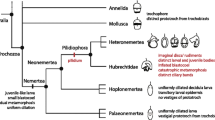Abstract
The two modes of development in sea urchins are direct development, in which the adult develops directly from the gastrula to the adult and does not feed, and indirect development, in which the adult develops indirectly through a feeding larva. In this account of the indirect, feeding larva of Heliocidaris tuberculata, the question raised is whether an evolutionary difference of unequal cell divisions contributes to the development of feeding structures in the indirect larva. In indirect development, the cell divisions at the fourth and fifth cell cycles of the zygote are unequal, with four small micromeres formed at the vegetal pole at the fifth cell division. In direct development, these cell divisions are not unequal. From their position at the head of the archenteron, the small micromeres are strategically located to contribute to the feeding tissues of the larva and the adult of H. tuberculata.






Similar content being viewed by others
References
Burke RD, Alvarez CM (1988) Development of the esophageal muscles in embryos of the sea urchin Strongylocentrotus purpuratus. Cell Tiss. Res 252:411–417
Byrne M, Emlet RB, Cerra A (2001) Ciliated band structure in planktotrophic and lecithotrophic larvae of Heliocidaris species (Echinodermata: Echinoidea): conservation and change. Acta Zool 82:189–199
Byrne M, Martinez P, Morris V (2016) Evolution of a pentameral body plan was not linked to translocation of anterior Hox genes: the echinoderm HOX cluster revisited. Evol Dev 18:137–143
Cameron RA, Davidson EH (1991) Cell type specification during sea urchin development. Trends in Genet 7:212–218
Campanale JP, Gökirmak T, Espinoza JA, Oulhen N, Wessel GM, Hamdoun A (2014). Migration of sea urchin primordial germ cells. Dev Dynamics 243:917–927
Cox, G. (2007). Optical imaging techniques in cell biology (Boca Raton, FL, CRC Press, Taylor and Francis)
Davidson EH, Cameron RA, Ransick A (1998) Specification of cell fate in the sea urchin embryo: summary and some proposed mechanisms. Development 125:3269–3290
Israel JW, Martik ML, Byrne M, Raff EC, Raff RA, McClay DR, Wray GA (2016) Comparative developmental transcriptomics reveals rewiring of a highly conserved gene regulatory network during a major life history switch in the sea urchin genus Heliocidaris. PLoS Biol 14(3):e1002391
Martik ML, McClay DR (2015) Deployment of a retinal determination gene network drives directed cell migration in the sea urchin embryo. eLife 4:e08827
Morrill, J.B., and Marcus, L. (2005). An atlas of the development of the sea urchin Lytechinus variegatus. Division of Natural Sciences, New College of Florida, Sarasota, Florida
Morris VB (1992) Spatial patterns of cells in dividing epithelia. J Theor Biol 159:343–360
Morris VB (2011) Coelomogenesis during the abbreviated development of the echinoid Heliocidaris erythrogramma and the developmental origin of the echinoderm pentameral body plan. Evol Dev 13:370–381
Morris VB (2016) Analysis of coelom development in the sea urchin Holopneustes purpurescens yielding a deuterostome body plan. Biology Open 5:348–358
Morris VB, Dixon KE, Cowan R (1989) The topology of cleavage patterns with examples from embryos of Nereis, Styela and Xenopus. Phil. Trans. R. Soc. Lond. B 325:1–36
Olivier N, Luengo-Oroz MA, Duloquin L, Faure E, Savy T, Veilleux I, Solinas X, Débarre D, Bourgine P, Santos A, Peyriéras N, Beaurepaire E (2010) Cell lineage reconstruction of early zebrafish embryos using label-free nonlinear microscopy. Science 329:967–971
Pehrson JR, Cohen LH (1986) The fate of the small micromeres in sea urchin development. Dev Biol 113:522–526
Raff RA (1987) Constraint, flexibility, and phylogenetic history in the evolution of direct development in sea urchins. Dev Biol 119:6–19
Raff RA, Byrne M (2006) The active evolutionary lives of echinoderm larvae. Heredity 97:244–252
Raz E (2000) The function and regulation of vasa-like genes in germ-cell development. Genome Biology 1(3):reviews1017.1–reviews1017.6
Smith MM, Smith LC, Cameron RA, Urry LA (2008) The larval stages of the sea urchin, Strongylocentrotus purpuratus. J Morphol 269:713–733
Tanaka S, Dan K (1990) Study of the lineage and cell cycle of small micromeres in embryos of the sea urchin, Hemicentrotus pulcherrimus. Dev Growth Diff 32:145–156
Voronina E, Lopez M, Juliano CE, Gustafson E, Song JL, Extavour C, George S, Oliveri P, McClay D, Wessel G (2008) Vasa protein expression is restricted to the small micromeres of the sea urchin, but is inducible in other lineages early in development. Dev Biol 314:276–286
Yajima M, Wessel GM (2012) Autonomy in specification of primordial germ cells and their passive translocation in the sea urchin. Development 139:3786–3794
Yajima M, Wessel GM (2015) Essential elements for translation: the germline factor Vasa functions broadly in somatic cells. Development 142:1960–1970
Yang H, Adam RC, Ge Y, Hua ZL, Fuchs E (2017) Epithelial-mesenchymal micro-niches govern stem cell lineage choices. Cell 169:483–496
Acknowledgments
The authors acknowledge the facilities and the scientific and technical assistance of the Australian Microscopy and Microanalysis Research Facility at the Australian Centre for Microscopy and Microanalysis, The University of Sydney.
Author information
Authors and Affiliations
Corresponding author
Additional information
Communicated by Mark Q. Martindale
Publisher’s note
Springer Nature remains neutral with regard to jurisdictional claims in published maps and institutional affiliations.
Rights and permissions
About this article
Cite this article
Morris, V.B., Kable, E., Koop, D. et al. Early development of the feeding larva of the sea urchin Heliocidaris tuberculata: role of the small micromeres. Dev Genes Evol 229, 1–12 (2019). https://doi.org/10.1007/s00427-018-0622-y
Received:
Accepted:
Published:
Issue Date:
DOI: https://doi.org/10.1007/s00427-018-0622-y




